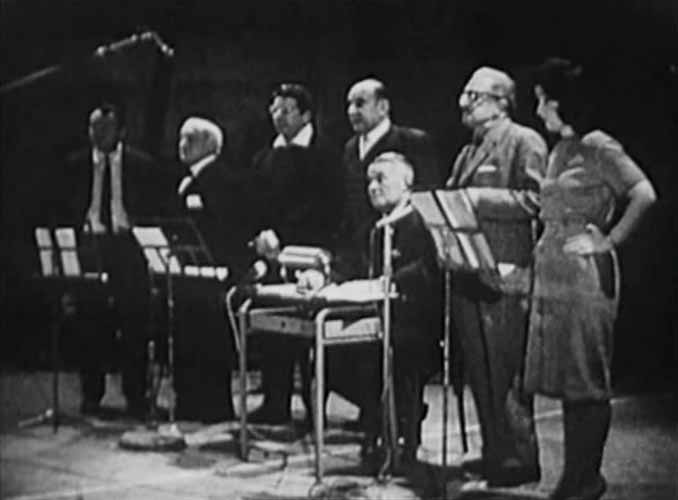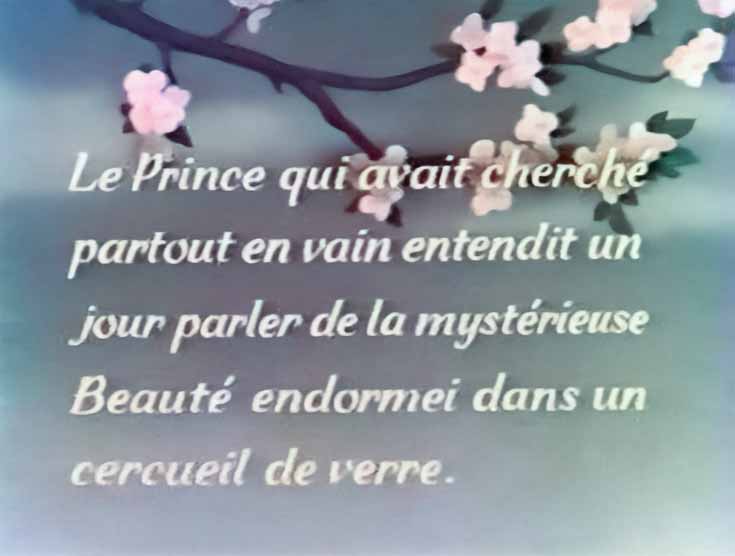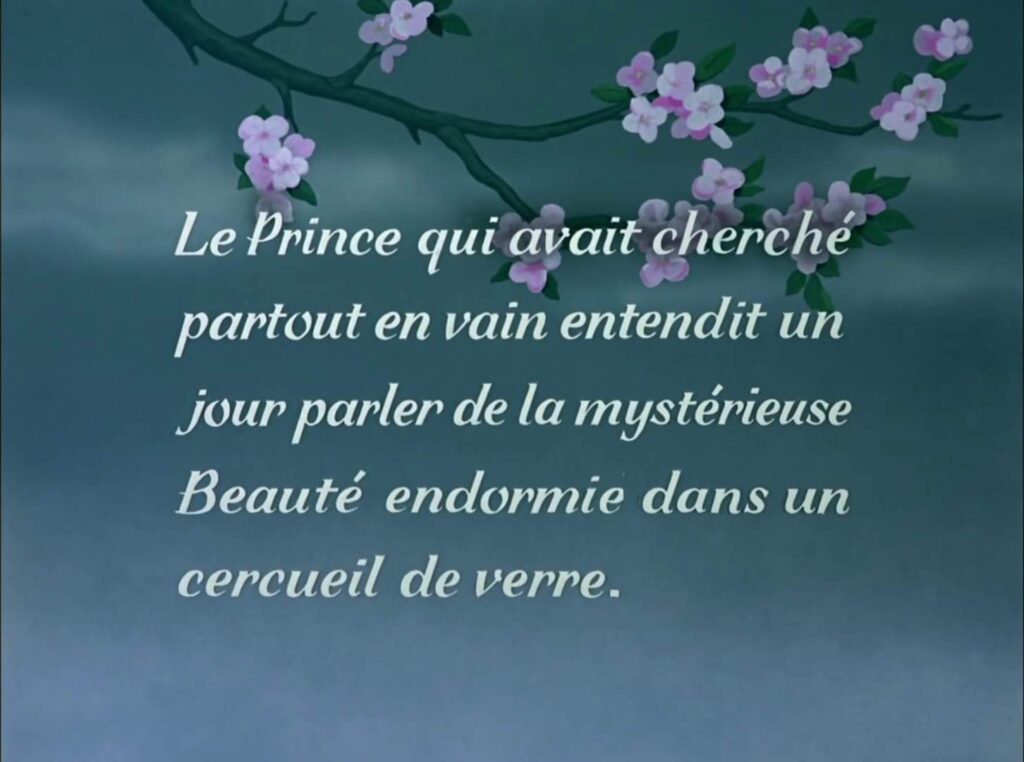Production information
General supervisor: Jack Cutting
Director: Serge Nadaud
Musical Director: André Theurer
Adapter: Pierre-François Caillé
Dubbing company: Société Parisienne de Sonorisation (S.P.S.)
Cast
Snow White: Lucie Dolène
The Queen: Claude Gensac
The Hag: Marie Francey
The Prince: Jean Cussac
The Slave in the Magic Mirror: Serge Nadaud
The Huntsman: André Valmy
Doc: Richard Francoeur
Grumpy: Léonce Corne
Happy: Raymond Rognoni
Sleepy: Georges Hubert
Bashful: Maurice Nasil
Sneezy: Jean Daurand
Singers and Chorus: Jean Cussac, Henri Tallourd, Pierre Marret, Claude Germain, José Germain, André Meurant, Claudine Meunier, Lucie Dolène.
This information was compiled from the work of François Justamand (La Gazette du Doublage), Rémi Carémel (Dans l’ombre des studios), and Olikos (Les Grands Classiques).
Back to Foreign adaptations

A need for something new
In 1958, Snow White and the Seven Dwarfs was released in the United States. The company that distributed Walt Disney’s films, RKO Radio Pictures, had since gone bankrupt. Problem: its logo was embedded in the visuals of all the credits of its feature films. In the case of Snow White, the logo appears at the end, and the company’s name appears in the third card of the opening credits.
A second consideration sounds the death knell for these credits: the film industry underwent a major change in the mid-1950s: the development of wide-screen formats such as CinemaScope, Vistavision and others. The change in screen format meant that exhibitors projected films shot in the same 1.33 format as before, cutting off the top and bottom of the image to make a larger picture and fill the screen, which was now wider than before. While this consideration is taken into account for new productions, in which care is taken not to place crucial information in these parts of the screen, the re-release of old films often results in a few severed heads and invisible feet. In the case of credits, even a few lines are lost.
To avoid this, and to overcome the previous problem, the credits of Snow White are reshot without mentioning the distributor. A new background was painted, as the previous one was no longer in the studio’s collections.
Thanks to this, new credits for foreign versions could be made as well, in particular the French version, which was released in 1962. The names of the artists who re-recorded the dialogues and songs on the soundtrack were also added. Indeed, since the sound quality and French mistakes of the first version had never satisfied studio managers, it was natural to change everything that could be changed, especially since, under the leadership of former animator Jack Cutting, promoted to head of foreign versions in the aftermath of the Second World War, dubbing techniques for in-house productions had been considerably modernized and standardized. An international version, combining music and sound effects, was now established for each film, and all that remained to do was to mix the foreign voices over it.
Old dubbing veterans
Cutting had to choose the ideal performers. His stroke of genius in his meticulous search for the heroine’s voice was to choose a lyric soprano with a radically different voice to Caselotti. Lucie Dolène, if she can indeed rise as high as the American in her arias when it’s necessary to connect with her voice, has an infinitely more mature voice and thus brings to the character a quality that was not so evident until then: her maternal sweetness.
The Queen is delightfully played by two actresses as dissimilar as they are brilliant: Claude Gensac takes on the role of the Sovereign at the beginning of the film, bringing her natural class to the character, who becomes all the more cruel as her voice reflects the beauty of her image. Marie Francey, who has dubbed the greatest since the ’30s, brings her experience to her interpretation of the Queen after her transformation. She is as diabolical and outrageous as the role demands.
The Prince, who sings much more than he speaks, borrows the charming voice of Jean Cussac, a prolific chorister in the 60s whose protean voice was also used for the songs of the dwarfs.
The rest of the cast are dubbing professionals, starting with the save in the mirror Serge Nadaud, also responsible for directing the cast. The big, easily recognizable voice of André Valmy has enabled him to dub Walter Matthau, Robert Mitchum and other testosterone-filled bad boys for decades before he took on the Huntsman. Richard Francoeur was almost an unavoidable dubbing actor in an impressive number of films from the 1930s, when he was Gary Cooper, to his death in 1971. His voice, then more mature but still seductive, enabled him to embody an utterly charming Doc, as well as in singing.
Grumpy is played by old Léonce Corne, the French voice of Groucho Marx, who undoubtedly brings the necessary mischievousness to the role.
Jean Daurand, voice of Sneezy, was the star of the group at the time, triumphing in the crime series The Last Five Minutes.
Raymond Rognoni, who had been acting since childhood, was as full-bodied as his character Happy. In fact, he was usually cast in flesh-and-blood roles dubbing Edward G. Robinson, Peter Lorre and others.
Georges Hubert, an eternal second in dubbing, plays the very short role of Sleepy.
A regular in Disney dubbing among many others, Maurice Nasil, after the role of the shy Flower in Bambi, takes on the role of Bashful here.



Releases and alterations
Visually, all the inserts that had been translated in 1938 were retained for this version, with one notable exception being the text before the last sequence that shows the passing seasons. Since these would have to be remade for languages that the film had not been translated in before, the studio also replaced the French animated titles by fixed ones and stupidly let two typos sneak in when there was no error before. The text now read “endormei” instead of “endormie” (meaning asleep) and “dans la morte” (in the dead one) instead of “dans la mort” (in death).
That version of the film came out in French theaters on December 12, 1962 with the slogan “Snow White comes back younger than ever.” It was rereleased on December 5, 1973, November 30, 1983, and February 12, 1992.
Some time before one of these reissues, the previously mentioned mistake was fixed and a new text was shot. In 1993, another change was made: the first sentence of the prop storybook was altered digitally to read the more common “Il était une fois”, instead of “ll y avait une fois” (Once upon a time). This arguably unnecessary change necessitated that the opening of the book be shortened, as that sentence was visible in the long shot.
This slightly altered version is the one used for the Laserdisc and VHS release in 1994, which is also the last time that the 1962 dubbing was used officially.
Specific features of this version
- Lucie Dolène sings several of the arias herself, for which Adriana Caselotti’s voice is often left in other versions, such as in the song “I’m Wishing”.
- The music cue in sequence 8C when the dwarfs fight over a pillow was not mixed in.
- The beginning of the line “Le coeur d’une biche” (The heart of a doe) when the Queen enters her secret lab in sequence 7A was incorrectly mixed in all prints from 1973. The resulting noise was edited out when the film was restored so that all prints from 1992 ommited “Le” and the line started at “coeur d’une biche”.
